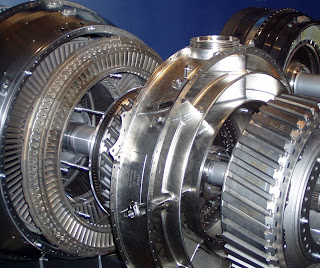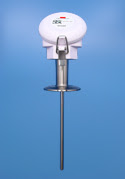Alliance Technical Sales, experienced provider of process analytical solutions throughout many industries, has added the Thornton brand of instruments to expand its offering of Mettler Toledo analytical products. Thornton specializes in on-line liquid process measurement solutions for pure and ultrapure water applications. The product line includes instrumentation and sensors providing high quality measurement of conductivity/resistivity, TOC, pH, ORP, dissolved oxygen, dissolved ozone, sodium, silica and bioburden. The Thornton line complements and expands the extent of Mettler Toledo products already available from Alliance Technical Sales.
Share your fluid process analytical challenges with product application experts, combining your process knowledge and experience with their product application expertise to develop effective solutions.
An informative and educational resource specializing in process control instrumentation, analytical instruments, and related industrial equipment. Content includes technology basics, how-to's, new product developments, and application notes. Blog is courtesy of Alliance Technical Sales, a leading Manufacturers' Rep headquartered in Clarendon Hills, IL and serving customers in Illinois, Indiana, Iowa, Michigan and Wisconsin.
Alliance Technical Sales Overview
 |
| Alliance Technical Sales works with customers to develop effective solutions to process measurement and control challenges. |
The professionals at Alliance combine world class products with real application expertise and passion to be the best at what they do. For over 15 years, the company has been helping its customers boost efficiency, safety, and effectiveness.
The company's current product offering is included below. Reach out to Alliance Technical Sales for a partner in solving your process measurement and control challenges.
Combustion Control in Gas Turbines
 |
| Proper inlet air control can boost gas turbine efficiency |
Vaisala, a globally recognized leader in the measurement of temperature and humidity, was authored a white paper application note that explains how the temperature and humidity of inlet air can contribute to combustion efficiency, as well as providing recommendations for measuring these parameters in gas turbine applications.
The white paper is included below. Share your process measurement requirements and challenges with application experts. Combine your process knowledge with their product application expertise to deliver effective solutions.
Tags:
combustion,
gas turbine,
humidity,
Illinois,
Indiana,
Iowa,
Michigan,
temperature,
Vaisala,
Wisconsin
Close Temperature Control of a Process Fluid Flow
 |
| Temperature sensor is one component of a successful temperature control system Courtesy Smart Sensors, Inc. |
Let's narrow the application range to non-flammable flowing fluids that require elevated temperatures. In the interest of clarity, this illustration is presented without any complicating factors that may be encountered in actual practice. Much of what is presented here, however, will apply universally to other scenarios.
What are the considerations for specifying the right equipment?
KNOW YOUR FLOW
- Specific Heat - The amount of heat input required to increase the temperature of a mass unit of the media by one degree.
- Minimum Inlet Temperature - The lowest media temperature entering the process and requiring heating to a setpoint. Use the worst (coldest) case anticipated.
- Mass Flow Rate - An element in the calculation for total heat requirement. If the flow rate will vary, use the maximum anticipated flow.
- Maximum Required Outlet Temperature - Used with minimum inlet temperature in the calculation of the maximum heat input required.
SELECT SYSTEM COMPONENTS WITH PERFORMANCE TO MATCH THE PROJECT
- Heat Source - If temperature control with little deviation from a setpoint is your goal, electric heat will likely be your heating source of choice. It responds quickly to changes in a control signal and the output can be adjusted in very small increments to achieve a close balance between process heat requirement and actual heat input.
- Sensor - Sensor selection is critical to attaining close temperature control. There are many factors to consider, well beyond the scope of this article, but the ability of the sensor to rapidly detect small changes in media temperature is a key element of a successful project. Attention should be given to the sensor containment, or sheath, the mass of the materials surrounding the sensor that are part of the assembly, along with the accuracy of the sensor.
- Sensor Location - The location of the temperature sensor will be a key factor in control system performance. The sensing element should be placed where it will be exposed to the genuine process condition, avoiding effects of recently heated fluid that may have not completely mixed with the balance of the media. Locate too close to the heater and there may be anomalies caused by the heater. A sensor installed too distant from the heater may respond too slowly. Remember that the heating assembly, in whatever form it may take, is a source of disturbance to the process. It is important to detect the impact of the disturbance as early and accurately as possible.
- Controller - The controller should provide an output that is compatible with the heater power controller and have the capability to provide a continuously varying signal or one that can be very rapidly cycled. There are many other features that can be incorporated into the controller for alarms, display, and other useful functions. These have little bearing on the actual control of the process, but can provide useful information to the opeartor.
- Power Controller - A great advantage of electric heaters is their compatibility with very rapid cycling or other adjustments to their input power. A power controller that varies the total power to the heater in very small increments will allow for fine tuning the heat input to the process.
- Performance Monitoring - Depending upon the critical nature of the heating activity to overall process performance, it may be useful to monitor not only the media temperature, but aspects of heater or controller performance that indicate the devices are working. Knowing something is not working sooner, rather than later, is generally beneficial. Controllers usually have some sort of sensor failure notification built in. Heater operation can be monitored my measurement of the circuit current.
SAFETY CONSIDERATIONS
- High Fluid Temperature - An independent sensor can monitor process fluid temperature, with instrumentation providing an alert and limit controllers taking action if unexpected limits are reached.
- Heater Temperature - Monitoring the heater sheath temperature can provide warning of a number of failure conditions, such as low fluid flow, no fluid present, or power controller failure. A proper response activity should be automatically executed when unsafe or unanticipated conditions occur.
- Media Present - There are a number of ways to directly or indirectly determine whether media is present. The media, whether gaseous or liquid, is necessary to maintain an operational connection between the heater assembly and the sensor.
- Flow Present - Whether gaseous or liquid media, flow is necessary to keep most industrial heaters from burning out. Understand the limitations and operating requirements of the heating assembly employed and make sure those conditions are maintained.
- Heater Immersion - Heaters intended for immersion in liquid may have watt density ratings that will produce excessive or damaging element temperatures if operated in air. Strategic location of a temperature sensor may be sufficient to detect whether a portion of the heater assembly is operating in air. An automatic protective response should be provided in the control scheme for this condition.
Direct Insertion Gaseous Oxygen Sensor - No Sampling
 |
| Ingold 6800G insertion sensor for gaseous oxygen Courtesy Mettler Toledo |
There is more to be learned. Reach out to a product application specialist and share your O2 measurement challenges. Combine your process knowledge with their product application expertise to develop the best solutions.
Tags:
gas,
Illinois,
Indiana,
Ingold,
Iowa,
measurement,
Mettler Toledo,
Michigan,
oxygen,
Wisconsin
New Laser Level Transmitter Brings Application Advantages for Process Measurement
Jogler, manufacturer of level measurement instruments, has released the new Model LLT 1000 Laser Level Transmitter for industrial process measurement and control applications. The newly designed instrument provides continuous non-contact level measurement for process automation and inventory management across an array of industrial applications.
The laser level transmitter provides reliable measurement of solids or liquids, even clear liquids. Long measuring range, narrow beam, and high accuracy make the LLT 1000 suitable for application in silos, tanks, hoppers, chutes, and bunkers.
The data sheet below provides more detail on the new level measurement instrument. Share your level measurement requirements and challenges with a product application specialist, combing your process knowledge with their product expertise to develop effective solutions.
The laser level transmitter provides reliable measurement of solids or liquids, even clear liquids. Long measuring range, narrow beam, and high accuracy make the LLT 1000 suitable for application in silos, tanks, hoppers, chutes, and bunkers.
The data sheet below provides more detail on the new level measurement instrument. Share your level measurement requirements and challenges with a product application specialist, combing your process knowledge with their product expertise to develop effective solutions.
New Website Design for Alliance Technical Sales
 |
| Alliance Technical Sales has a redesigned website |
The newly designed site provides simple and rapid access to technical information regarding an array of process measurement and control products. Direct links to represented manufacturers is provided, as well as simple contact avenues to get visitors information quickly. The site is mobile friendly, adjusting its layout to accommodate whatever device the visitor is using and provide easily readable page views.
ATS now has an ongoing social media presence, with weekly blog posts about products and technical issues. All of the social media channels are directly accessible from the website.
Alliance Technical Sales is fully committed to providing top flight service to its customers. Visit the new website and reach out to ATS with your process measurement and control challenges.
Subscribe to:
Comments (Atom)

